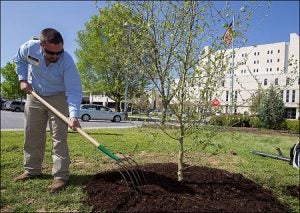Tree’s roots trace back to ancient Greece
East Carolina University might be the youngest medical school in the state, but an addition to its campus has a lineage that goes back thousands of years to the father of medicine himself.
A descendant of the “Tree of Hippocrates” is now growing in front of the Brody Medical Sciences Building. The tree was propagated locally from seed from a tree at the National Library of Medicine. That tree grew from a cutting off of a tree on the Greek island of Cos. That tree’s parent is where Hippocrates is said to have taught medicine to his students.

Dr. Walter Pories inspects a tree transplanted from his farm to the campus of the Brody School of Medicine. The tree is a descendent of the “Tree of Hippocrates.” Photo by Doug Boyd
The tree, Plantanus orientalis, or Oriental plane tree, is related to the American sycamore, Platanus occidentalis. Grounds staff members at the National Institutes of Health (which includes the NLM) made numerous attempts to grow cuttings and seeds from the tree it received from Cos, but none survived. That’s where Dr. Walter Pories, an ECU surgeon and researcher of most anything he takes an interest in, took over.

Todd Inman of the ECU grounds department prunes the oriental plane tree planted March 27 on the campus of the Brody School of Medicine. Photo by Cliff Hollis
Five years ago, during a visit to the library, he saw the tree with a plaque identifying it as the Tree of Hippocrates along with a message about the tree’s history. “In view of the construction at ECU, I thought it would be fun to plant another descendant on our campus,” Pories wrote in a letter about the tree. “However, I was unaware how difficult it is to propagate this species of tree.”
He collected seeds, but none germinated. He tried again in 2008 with cuttings. All died. “In 2009, still determined, I collected another set of seeds,” Pories wrote. “According to instructions from a forester, I put six in the freezer before planting, I gave another six to a forestry professor from N.C. State and the last six to Tommy Lassiter at the Plant and See Nursery here in Greenville. Again, mine failed to germinate as did those of the professor, but in (the) fall, Mr. Lassiter called me and asked me what he ‘should do with all those trees.'”
Pories took several to his Falkland farm and gave one each to Dr. Paul Cunningham, dean of the Brody School of Medicine, and Steve Lawler, president of Vidant Medical Center.
In late March, a landscaping crew from ECU dug up one of the trees at Pories’ farm and transplanted it on the Brody campus. It’s in the grassy island between the two main parking lots in front of the Brody Building.

Robert Frizzell of the ECU grounds department spreads mulch around the oriental plane tree planted March 27 on the campus of the Brody School of Medicine. Photo by Cliff Hollis
John Gill, the university landscape architect, said crews will keep a close eye on the tree as it gets accustomed to its new home. Once it begins to mature and branch out, it could be a spot for teaching, just as its ancestor was in ancient Greece.
“It’s a cool tree, it has a great history, and the great thing is (Dr. Pories has) a couple more at his farm,” Gill said.
Pories’ story goes further.
“I was reminded that I had stolen federal property and that I needed to make peace with someone to be sure that we could use the tree,” he said. “Accordingly, after a discussion with the leadership of the NIDDK (National Institute of Diabetes and Digestive and Kidney Diseases), who support our research, I was referred to the head of the grounds department.
“They were delighted to learn that we had propagated the tree and asked if they could have one or two with the explanation that they always kept one or two ‘stand-ins’ for ceremonial trees, but they had been unable to propagate this one in spite of all sorts of tries.”